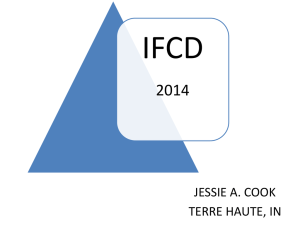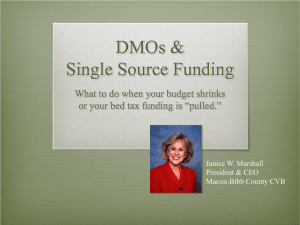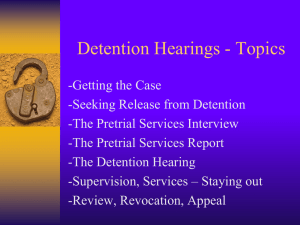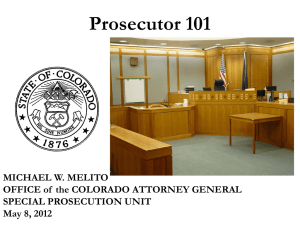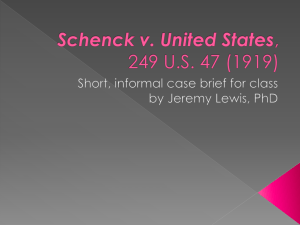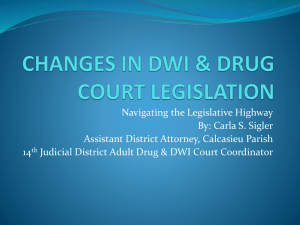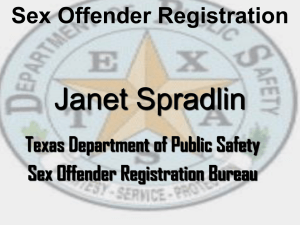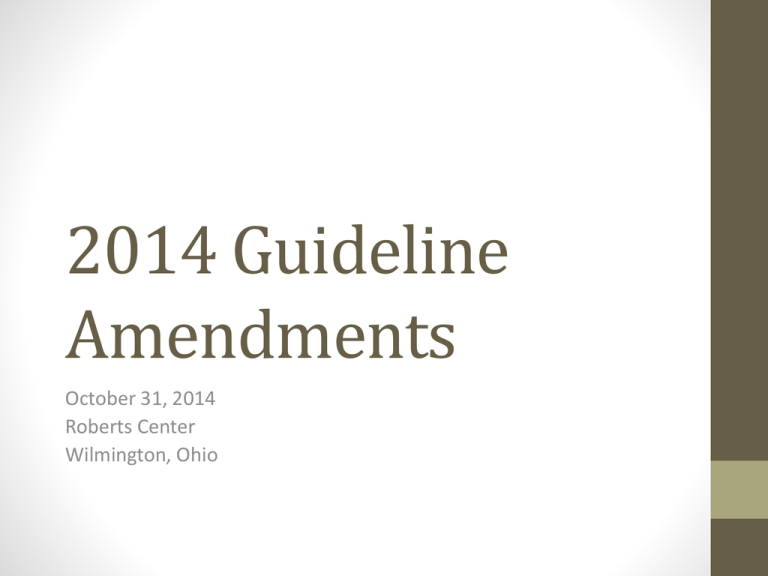
2014 Guideline
Amendments
October 31, 2014
Roberts Center
Wilmington, Ohio
§ 1B1.10. Reduction in Term of Imprisonment as a
Result of Amended Guideline Range
(a) Authority.— (1) In General.—In a case in which a
defendant is serving a term of imprisonment, and the
guideline range applicable to that defendant has
subsequently been lowered as a result of an
amendment to the Guidelines Manual listed in
subsection (d) below, the court may reduce the
defendant’s term of imprisonment as provided by 18
U.S.C. § 3582(c)(2). As required by this statute, any
such reduction in the defendant’s term of
imprisonment shall be consistent with this policy
statement.
Reason for Amendment:
This amendment clarifies an application issue that
has arisen with respect to §1B1.10 (Reduction in
Term of Imprisonment as a Result of Amended
Guideline Range) (Policy Statement). Circuits have
conflicting interpretations of when, if at all, §1B1.10
provides that a statutory minimum continues to limit
the amount by which a defendant’s sentence may be
reduced under 18 U.S.C. § 3582(c)(2) when the
defendant’s original sentence was below the statutory
minimum due to substantial assistance.
This issue arises in two situations. First, there are
cases in which the defendant's original guideline
range was above the mandatory minimum but the
defendant received a sentence below the mandatory
minimum pursuant to a government motion for
substantial assistance. § 5K1.1.
Second, there are cases in which the defendant's
original guideline range as determined by the
Sentencing Table was, at least in part, below the
mandatory minimum, and the defendant received a
sentence below the mandatory minimum pursuant to
a government motion for substantial assistance.
The Eighth Circuit has taken the view that the bottom of the
amended guideline range in such a case would be 240 months,
i.e., the guideline sentence that results after application of the
"trumping“ mechanism in §5G1.1. See United States v. Golden,
709 F.3d 1229, 1231-33 (8th Cir. 2013).
In contrast, the Seventh Circuit has taken the view that the
bottom of the amended guideline range in such a case would be
168 months, i.e., the bottom of the amended range as
determined by the Sentencing Table, without application of the
"trumping" mechanism in §5G1.1. See United States v. Wren,
706 F.3d 861,863 (7th Cir. 2013). Each circuit found support for
its view in an Eleventh Circuit decision, United States v. Liberse,
688 F.3d 1198 (11th Cir. 2012), which also discussed this issue.
The amendment generally adopts the approach of the
Third Circuit in Savani and the District of Columbia
Circuit in In re Sealed Case. It amends §1B1.10 to
specify that, if the case involves a statutorily required
minimum sentence and the court had the authority to
impose a sentence below the statutorily required
minimum sentence pursuant to a government motion
to reflect the defendant's substantial assistance to
authorities, then for purposes of §1B1.10 the
amended guideline range shall be determined without
regard to the operation of §5G1.1 and §5G1.2. The
amendment also adds a new application note with
examples.
VIOLENCE AGAINST WOMEN
REAUTHORIZATION ACT
This amendment responds to recent statutory
changes made by the Violence Against
Women Reauthorization Act of 2013 which
provided new and expanded criminal offenses
and increased penalties for certain crimes
pertaining to assault, sexual abuse, stalking,
domestic violence, and human trafficking.
§ 2A2.2. Aggravated Assault
§2A2.2(a)(4)
If the offense involved strangling, suffocating, or attempting
to strangle or suffocate a spouse, intimate partner, or
dating partner, increase by 3 levels. However, the
cumulative adjustments from application of subdivisions
(2), (3), and (4) shall not exceed 12 levels.
§2A2.3. Minor Assault
§2A2.3(b)(1)
If (A) the victim sustained bodily injury, increase by 2
levels; or (B) the offense resulted in substantial bodily
injury to a spouse, intimate partner, or dating partner, or an
individual under the age of sixteen years, increase by 4
levels.
§ 2A6.2. Stalking or Domestic
Violence
§ 2A6.2(b)(1)
If the offense involved one of the following aggravating factors:
(A) the violation of a court protection order; (B) bodily injury;
(C) strangling, suffocating, or attempting to strangle or
suffocate; (D) possession, or threatened use, of a dangerous
weapon; or (D)(E) a pattern of activity involving stalking,
threatening, harassing, or assaulting the same victim, increase
by 2 levels. If the offense involved more than one of subdivisions
(A), (B), (C), (D), or (E), increase by 4 levels.
§5D1.1, Imposition of a Term of
Supervised Release
§5D1.1.
Commentary(D) Domestic Violence.—If the defendant is convicted for
the first time of a domestic violence crime as defined in 18
U.S.C. § 3561(b), a term of supervised release is required
by statute. See 18 U.S.C. § 3583(a). Such a defendant is
also required by statute to attend an approved
rehabilitation program, if available within a 50-mile radius
of the legal residence of the defendant. See 18 U.S.C. §
3583(d); §5D1.3(a)(3). In any other case involving
domestic violence or stalking in which the defendant is
sentenced to imprisonment, it is highly recommended that
a term of supervised release also be imposed.
DRUGS
Reason for Amendment: This amendment revises
the guidelines applicable to drug trafficking offenses
by changing how the base offense levels in the Drug
Quantity Table in §2D1.1 (Unlawful Manufacturing,
Importing, Exporting or Trafficking (Including
Possession with Intent to Commit These Offenses);
Attempt or Conspiracy) incorporate the statutory
mandatory minimum penalties for such offenses.
Specifically, the amendment reduces by two levels the offense
levels assigned to the quantities that trigger the statutory
mandatory minimum penalties, resulting in corresponding
guideline ranges that include the mandatory minimum penalties.
Accordingly, offenses involving drug quantities that trigger a fiveyear statutory minimum are assigned a base offense level of 24
(51 to 63 months at Criminal History Category I, which includes
the five-year (60 month) statutory minimum for such offenses),
and offenses involving drug quantities that trigger a ten-year
statutory minimum are assigned a base offense level of 30 (97 to
121 months at Criminal History Category I, which includes the
ten-year (120 month) statutory minimum for such offenses).
Offense levels for quantities above and below the mandatory
minimum threshold quantities similarly are adjusted downward
by two levels, except that the minimum base offense level of 6
and the maximum base offense level of 38 for most drug types is
retained, as are previously existing minimum and maximum base
offense levels for particular drug types.
The amendment also makes parallel changes to the
quantity tables in §2D1.11 (Unlawfully Distributing,
Importing, Exporting or Possessing a Listed
Chemical; Attempt or Conspiracy), which apply to
offenses involving chemical precursors of controlled
substances. Section 2D1.11 is generally structured to
provide offense levels that are tied to, but less severe
than, the base offense levels in §2D1.1 for offenses
involving the final product.
The Commission considered the amendment an
appropriate step toward alleviating the overcapacity of the
federal prisons. Based on an analysis of the 24,968
offenders sentenced under §2D1.1 in fiscal year 2012, the
Commission estimates the amendment will affect the
sentences of 17,457 — or 69.9 percent — of drug
trafficking offenders sentenced under §2D1.1, and their
average sentence will be reduced by 11 months — or 17.7
percent — from 62 months to 51 months. The Commission
estimates these sentence reductions will correspond to a
reduction in the federal prison population of approximately
6,500 inmates within five years after its effective date.
Marijuana Cultivation
Operations
Reason for Amendment: This amendment provides increased
punishment for certain defendants involved in marihuana
cultivation operations on state or federal land or while
trespassing on tribal or private land. The amendment adds a new
specific offense characteristic at subsection (b)(14) of §2D1.1
(Unlawful Manufacturing, Importing, Exporting or Trafficking
(Including Possession with Intent to Commit These Offenses);
Attempt or Conspiracy). The new specific offense characteristic
provides an increase of two levels if the defendant receives an
adjustment under §3B1.1 (Aggravating Role) and the offense
involved the cultivation of marihuana on state or federal land or
while trespassing on tribal or private land. The amendment
responds to concerns raised by federal and local elected
officials, law enforcement groups, trade groups, environmental
advocacy groups and others, especially in areas of the country
where unlawful outdoor marihuana cultivation is occurring with
increasing frequency.
§2D1.1. Unlawful Manufacturing, Importing,
Exporting, or Trafficking (Including Possession
with Intent to Commit These Offenses); Attempt or
Conspiracy
(b) (14) If (A) the offense involved the cultivation of
marihuana on state or federal land or while trespassing on
tribal or private land; and (B) the defendant receives an
adjustment under §3B1.1 (Aggravating Role),
increase by 2 levels.
New Application Note
19. Application of Subsection (b)(14).—Subsection
(b)(14) applies to offenses that involve the cultivation
of marihuana on state or federal land or while
trespassing on tribal or private land. Such offenses
interfere with the ability of others to safely access and
use the area and also pose or risk a range of other
harms, such as harms to the environment. The
enhancements in subsection (b)(13)(A) and (b)(14)
may be applied cumulatively (added together), as is
generally the case when two or more specific offense
characteristics each apply. See §1B1.1 (Application
Instructions), Application Note 4(A).
§ 2D1.1(b)(15) now (b)(16)
(b)(16) If the defendant receives the 4-level ("minimal
participant") reduction in §3B1.2(a) and the offense involved all
of the following factors:
(A) the defendant was motivated by an intimate or familial
relationship or by threats or fear to commit the offense and was
otherwise unlikely to commit such an offense;
(B) the defendant received no monetary compensation from the
illegal purchase, sale, transport, or storage of controlled
substances; and
(C) the defendant had minimal knowledge of the scope and
structure of the enterprise,
decrease by 2 levels.
New Location of Safety Valve
(b)(17) If the defendant meets the criteria set forth in
subdivisions (1)-(5) of subsection (a) of §5C1.2 (Limitation
on Applicability of Statutory Minimum Sentences in
Certain Cases), decrease by 2 levels.
FELON IN POSSESSION
Reason for Amendment: This amendment addresses cases in
which the defendant is convicted of a firearms offense (in
particular, being a felon in possession of a firearm) and also
possessed a firearm in connection with another offense, such as
robbery or attempted murder. In such a case, the defendant is
sentenced under the firearms guideline, §2K2.1 (Unlawful
Receipt, Possession, or Transportation of Firearms or
Ammunition; Prohibited Transactions Involving Firearms or
Ammunition). If the defendant possessed any firearm in
connection with another felony offense, subsection (b)(6)(B)
provides a 4-level enhancement and a minimum offense level of
18. If the defendant possessed any firearm in connection with
another offense, subsection (c)(1) provides a cross reference to
the offense guideline applicable to the other offense, if it results
in a higher offense level. (For example, if the defendant
possessed any firearm in connection with a robbery, a cross
reference to the robbery guideline may apply.)
The amendment clarifies how relevant conduct
principles operate in determining whether subsections
(b)(6)(B) and (c)(1) apply. Subsections (b)(6)(B) and
(c)(1) are not intended to apply only when the other
felony offense is a "groupable" offense. Instead, the
central question for the court in these cases is
whether the defendant's two firearms offenses — the
firearms offense of conviction, and his unlawful
possession of a firearm in connection with the other
felony offense — were "part of the same course of
conduct or common scheme or plan". See
§1B1.3(a)(2). The amendment adds examples to the
commentary to clarify how relevant conduct principles
are intended to operate in this context.
While relevant conduct principles provide a limitation
on the scope of subsection (c)(1) (and, as discussed
above, this amendment clarifies how those principles
operate in this context), the Commission determined
that a further limitation on the scope of subsection
(c)(1) is appropriate. Specifically, the instant offense
and the other offense must be related to each other
by, at a minimum, having an identifiable firearm in
common. Accordingly, the amendment revises the
cross reference so that it applies only to the particular
firearm or firearms cited in the offense of conviction.
Amendment:
§2K2.1. Unlawful Receipt, Possession, or
Transportation of Firearms or Ammunition;
Prohibited Transactions Involving Firearms or
Ammunition
(c) Cross Reference
(1) If the defendant used or possessed any firearm or
ammunition cited in the offense of conviction in
connection with the commission or attempted commission
of another offense, or possessed or transferred a firearm or
ammunition cited in the offense of conviction with
knowledge or intent that it would be used or possessed in
connection with another offense, apply—
New Application Note
14(E) Relationship Between the Instant Offense and
the Other Offense.—In determining whether
subsections (b)(6)(B) and (c)(1) apply, the court must
consider the relationship between the instant offense
and the other offense, consistent with relevant
conduct principles. See §1B1.3(a)(1)–(4) and
accompanying commentary. In determining whether
subsection (c)(1) applies, the court must also consider
whether the firearm used in the other offense was a
firearm cited in the offense of conviction. For example:
(i) Firearm Cited in the Offense of Conviction. Defendant A's
offense of conviction is for unlawfully possessing a shotgun on
October 15. The court determines that, on the preceding
February 10, Defendant A used the shotgun in connection with a
robbery. Ordinarily, under these circumstances, subsection
(b)(6)(B) applies, and the cross reference in subsection (c)(1)
also applies if it results in a greater offense level. Ordinarily, the
unlawful possession of the shotgun on February 10 will be "part
of the same course of conduct or common scheme or plan" as
the unlawful possession of the same shotgun on October 15.
See §1B1.3(a)(2) and accompanying commentary (including, in
particular, the factors discussed in Application Note 9 to §1B1.3).
The use of the shotgun "in connection with" the robbery is
relevant conduct because it is a factor specified in subsections
(b)(6)(B) and (c)(1). See §1B1.3(a)(4) ("any other information
specified in the applicable guideline").
(ii) Firearm Not Cited in the Offense of Conviction.
Defendant B's offense of conviction is for unlawfully
possessing a shotgun on October 15. The court
determines that, on the preceding February 10, Defendant
B unlawfully possessed a handgun (not cited in the offense
of conviction) and used the handgun in connection with a
robbery. Subsection (b)(6)(B). In determining whether
subsection (b)(6)(B) applies, the threshold question for the
court is whether the two unlawful possession offenses (the
shotgun on October 15 and the handgun on February 10)
were "part of the same course of conduct or common
scheme or plan". See §1B1.3(a)(2) and accompanying
commentary (including, in particular, the factors discussed
in Application Note 9 to §1B1.3).
If they were, then the handgun possession offense is
relevant conduct to the shotgun possession offense, and
the use of the handgun "in connection with" the robbery is
relevant conduct because it is a factor specified in
subsection (b)(6)(B). See §1B1.3(a)(4) ("any other
information specified in the applicable guideline").
Accordingly, subsection (b)(6)(B) applies. On the other
hand, if the court determines that the two unlawful
possession offenses were not "part of the same course of
conduct or common scheme or plan," then the handgun
possession offense is not relevant conduct to the shotgun
possession offense and subsection (b)(6)(B) does not
apply. Subsection (c)(1). Under these circumstances, the
cross reference in subsection (c)(1) does not apply,
because the handgun was not cited in the offense of
conviction.
ALIEN SMUGGLING
Reason for Amendment: This
amendment accounts for the risks of
death, injury, starvation, dehydration, or
exposure that aliens potentially face
when transported through dangerous
and remote geographical areas, e.g.,
along the southern border of the United
States.
The amendment adds to Application Note 5 the
following new example of the conduct to which
§2L1.1(b)(6) could apply: "or guiding persons through,
or abandoning persons in, a dangerous or remote
geographic area without adequate food, water,
clothing, or protection from the elements."
The Commission determined that this new example
will clarify application of subsection (b)(6), highlight
the potential risks in these types of cases, provide
guidance for the courts to determine whether to apply
the enhancement, and promote uniformity in
sentencing by providing factors to consider when
determining whether to apply §2L1.1(b)(6).
SUPERVISED RELEASE
Reason for Amendment: This amendment resolves
a circuit conflict and a related guideline application
issue about the calculation of terms of supervised
release. The circuit conflict involves defendants
sentenced under statutes providing for mandatory
minimum terms of supervised release, while the
application issue relates specifically to defendants
convicted of failure to register as a sex offender, in
violation of 18 U.S.C. § 2250.
For certain terrorism-related and sex offenses,
§5D1.2(b) operates to replace the top end of
the guideline term calculated under
subsection (a) with a life term of supervised
release. In the case of a "sex offense," as
defined by Application Note 1 to §5D1.2, a
policy statement recommends that a life term
of supervised release be imposed. See
§5D1.2(b), p.s. Finally, §5D1.2(c) states that
"the term of supervised release imposed shall
be not less than any statutorily required term
of supervised release."
When a Statutory Minimum Term of
Supervised Release Applies
The amendment adopts the approach of the
Seventh Circuit in Gibbs and Goodwin. The
amendment provides a new Application Note
and examples explaining that, under
subsection (c), a statutorily required minimum
term of supervised release operates to restrict
the low end of the guideline term of
supervised release.
When the Defendant is Convicted of
Failure to Register as a Sex Offender
The Commission agrees with the Seventh Circuit that
failure to register is not an offense that is
"perpetrated against a minor." In addition, expert
testimony and research reviewed by the Commission
indicated that commission of a failure-to-register
offense is not correlated with sex offense recidivism.
The amendment resolves the application issue by
amending the commentary to §5D1.2 to clarify that
offenses under Section 2250 are not "sex offenses."
Application Note 1
Application Notes:
1. Definitions.—For purposes of this guideline: "Sex
offense" means (A) an offense, perpetrated against a
minor, under (i) chapter 109A of title 18, United States
Code; (ii) chapter 109B of such title; (iii)(ii) chapter 110 of
such title, not including a recordkeeping offense; (iv)(iii)
chapter 117 of such title, not including transmitting
information about a minor or filing a factual statement
about an alien individual; (v)(iv) an offense under 18
U.S.C. § 1201; or (vi)(v) an offense under 18 U.S.C. §
1591; or (B) an attempt or a conspiracy to commit any
offense described in subdivisions (A)(i) through (vi)(v) of
this note. Such term does not include an offense under
18 U.S.C. § 2250 (Failure to register).
Application Note 6
6. Application of Subsection (c).—Subsection (c) specifies
how a statutorily required minimum term of supervised
release may affect the minimum term of supervised
release provided by the guidelines. For example, if
subsection (a) provides a range of two years to five years,
but the relevant statute requires a minimum term of
supervised release of three years and a maximum term of
life, the term of supervised release provided by the
guidelines is restricted by subsection (c) to three years to
five years. Similarly, if subsection (a) provides a range of
two years to five years, but the relevant statute requires a
minimum term of supervised release of five years and a
maximum term of life, the term of supervised release
provided by the guidelines is five years.
The following example illustrates the interaction of subsections
(a) and (c) when subsection (b) is also involved. In this example,
subsection (a) provides a range of two years to five years; the
relevant statute requires a minimum term of supervised release
of five years and a maximum term of life; and the offense is a sex
offense under subsection (b). The effect of subsection (b) is
to raise the maximum term of supervised release from five years
(as provided by subsection (a)) to life, yielding a range of two
years to life. The term of supervised release provided by the
guidelines is then restricted by subsection (c) to five years to life.
In this example, a term of supervised release of more than five
years would be a guideline sentence. In addition, subsection (b)
contains a policy statement recommending that the maximum —
a life term of supervised release — be imposed.
OTHER TERMS OF IMPRISONMENT
Reason for Amendment: This multi-part
amendment addresses certain cases in which
the defendant is subject to another term of
imprisonment, such as an undischarged term
of imprisonment or an anticipated term of
imprisonment. The guideline generally
applicable to undischarged terms of
imprisonment is §5G1.3 (Imposition of a
Sentence on a Defendant Subject to an
Undischarged Term of Imprisonment).
The amendment amends §5G1.3(b) to require a court
to adjust the sentence and impose concurrent
sentences in any case in which the prior offense is
relevant conduct under the provisions of §1B1.3(a)(1),
(a)(2), or (a)(3), regardless of whether the conduct
from the prior offense formed the basis for a Chapter
Two or Chapter Three increase. The Commission
determined that this amendment will simplify the
operation of §5G1.3(b) and will also address concerns
that the requirement that the relevant conduct
increase the offense level under Chapters Two or
Three is somewhat arbitrary.
Second, the amendment addresses cases in which
there is an anticipated, but not yet imposed, state
term of imprisonment that is relevant conduct to the
instant offense of conviction under the provisions of
subsections (a)(1), (a)(2), or (a)(3) of §1B1.3
(Relevant Conduct). This amendment creates a new
subsection (c) at §5G1.3 that directs the court to
impose the sentence for the instant federal offense to
run concurrently with the anticipated but not yet
imposed period of imprisonment if §5G1.3(a) does not
apply. This amendment is a further response to the
Supreme Court’s decision in Setser v. United States,
132 S. Ct. 1463 (2012).
The amendment provides a new departure provision in §2L1.2
(Unlawfully Entering or Remaining in the United States) for cases
in which the defendant is located by immigration authorities while
the defendant is in state custody, whether pre- or postconviction, for a state offense unrelated to the federal illegal
reentry offense. In such a case, the time served is not covered
by an adjustment under §5G1.3(b) and, accordingly, is not
covered by a departure under §5K2.23 (Discharged Terms of
Imprisonment). The new departure provision states that, in such
a case, the court may consider whether a departure is
appropriate to reflect all or part of the time served in state
custody for the unrelated offense, for the time federal
immigration authorities locate the defendant until the service of
the federal sentence commences, that the court determines will
not be credited to the federal sentence by the Bureau of Prisons.
The new departure provision also sets forth factors for the court
to consider in determining whether to provide such a departure,
and states that a departure should be considered only if the
departure will not increase the risk to the public from further
crimes of the defendant.
Amendment:
§2L1.2. Unlawfully Entering or Remaining in the United
States
Application Note 8. Departure Based on Time Served in State
Custody.
—In a case in which the defendant is located by immigration
authorities while the defendant is serving time in state custody,
whether pre- or post-conviction, for a state offense, the time
served is not covered by an adjustment under §5G1.3(b) and,
accordingly, is not covered by a departure under §5K2.23
(Discharged Terms of Imprisonment). See §5G1.3(a). In such a
case, the court may consider whether a departure is appropriate
to reflect all or part of the time served in state custody, from the
time immigration authorities locate the defendant until the service
of the federal sentence commences, that the court determines
will not be credited to the federal sentence by the Bureau of
Prisons. Any such departure should be fashioned to achieve a
reasonable punishment for the instant offense.
Such a departure should be considered only in cases
where the departure is not likely to increase the risk to the
public from further crimes of the defendant. In determining
whether such a departure is appropriate, the court should
consider, among other things, (A) whether the defendant
engaged in additional criminal activity after illegally
reentering the United States; (B) the seriousness of any
such additional criminal activity, including (1) whether the
defendant used violence or credible threats of violence or
possessed a firearm or other dangerous weapon (or
induced another person to do so) in connection with the
criminal activity, (2) whether the criminal activity resulted in
death or serious bodily injury to any person, and (3)
whether the defendant was an organizer, leader, manager,
or supervisor of others in the criminal activity; and (C) the
seriousness of the defendant's other criminal history.
§5G1.3. Imposition of a Sentence on a Defendant
Subject to an Undischarged Term of Imprisonment or
Anticipated State Term of Imprisonment
(c) If subsection (a) does not apply, and a state term of
imprisonment is anticipated to result from another offense
that is relevant conduct to the instant offense of conviction
under the provisions of subsections (a)(1), (a)(2), or (a)(3)
of §1B1.3 (Relevant Conduct), the sentence for the instant
offense shall be imposed to run concurrently to the
anticipated term of imprisonment.
Application Note 3
3. Application of Subsection (c).—Subsection (c)
applies to cases in which the federal court anticipates
that, after the federal sentence is imposed, the
defendant will be sentenced in state court and serve a
state sentence before being transferred to federal
custody for federal imprisonment. In such a case,
where the other offense is relevant conduct to the
instant offense of conviction under the provisions of
subsections (a)(1), (a)(2), or (a)(3) of §1B1.3
(Relevant Conduct), the sentence for the instant
offense shall be imposed to run concurrently to the
anticipated term of imprisonment.
§5K2.23. Discharged Terms of
Imprisonment (Policy Statement)
A downward departure may be appropriate if the defendant
(1) has completed serving a term of imprisonment; and (2)
subsection (b) of §5G1.3 (Imposition of a Sentence on a
Defendant Subject to Undischarged Term of Imprisonment
or Anticipated Term of Imprisonment) would have
provided an adjustment had that completed term of
imprisonment been undischarged at the time of sentencing
for the instant offense. Any such departure should be
fashioned to achieve a reasonable punishment for the
instant offense.

